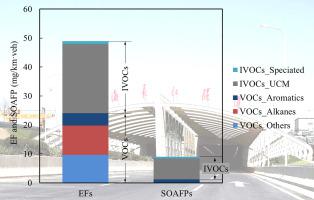Science of the Total Environment ( IF 9.8 ) Pub Date : 2021-05-15 , DOI: 10.1016/j.scitotenv.2021.147795 Jianyi Tang 1 , Yingjie Li 2 , Xinling Li 3 , Sheng'ao Jing 2 , Cheng Huang 2 , Jiping Zhu 4 , Qingyao Hu 2 , Hongli Wang 2 , Jun Lu 2 , Shengrong Lou 2 , Pinhua Rao 5 , Dandan Huang 2

|
Real-world vehicle emission factors (EFs) for the total intermediate volatile organic compounds (total-IVOCs) and volatile organic compounds (VOCs) from mixed fleets of vehicles were quantified in the Yangtze tunnel in Shanghai. Relationships of EFs of IVOCs with fleet compositions and vehicle speed as well as secondary organic formation potentials (SOAFPs) from IVOCs and VOCs were studied. Multiple linear regression (MLR) was used to estimate EFs of total-IVOCs for gasoline and diesel vehicles. IVOCs were classified into unresolved complex mixtures (unspeciated cyclic compounds and branched alkanes (b-alkanes)) and speciated targets (11 n-alkanes and ten polycyclic aromatic hydrocarbons (PAHs)). The results showed that the average EF of total-IVOCs was 24.9 ± 7.8 mg/(km·veh), which was comparable to that of VOCs. Unspeciated cyclic compounds and b-alkanes dominated the main composition (~77% and ~19%), followed by n-alkanes (~4%) and PAHs (~1%). EFs of IVOCs showed a significant, positive relationship with diesel vehicle fractions (p < 0.05). EFs of IVOCs dropped notably with the decrease of the diesel vehicle fractions. SOAFP produced by the total organic compounds (IVOCs + VOCs) was 8.9 ± 2.5 mg/(km·veh), in which up to 86% of SOAFP was from IVOCs. Estimated EFs of total-IVOCs for gasoline vehicles and diesel vehicles were 15.3 and 219.8 mg/(km·veh) respectively. Our results demonstrate that IVOCs emitted from diesel vehicles are the main emission sources under real world conditions and significant contributions of IVOCs emissions to SOA formation is evident, which indicates the necessity of making control policies to reduce IVOCs emissions from vehicles.
中文翻译:

实际条件下车辆产生的中间挥发性有机化合物排放量
在上海长江隧道中对来自混合车队的中间挥发性有机化合物总量(IVOCs)和挥发性有机化合物(VOCs)的实际车辆排放因子进行了量化。研究了IVOC的EF与车队组成和车速以及IVOC和VOC的二次有机形成潜能(SOAFP)的关系。多元线性回归(MLR)用于估算汽油和柴油车辆的总IVOC的EF。IVOCs分为未分离的复杂混合物(未指定的环状化合物和支链烷烃(b-烷烃))和指定的目标(11个正构烷烃和十个多环芳烃(PAHs))。结果表明,总IVOC的平均EF为24.9±7.8 mg /(km·veh),与VOC相当。未指明的环状化合物和b-烷烃占主要组成(〜77%和〜19%),其次是正构烷烃(〜4%)和PAHs(〜1%)。IVOC的EFs与柴油车辆的分数呈显着正相关(p <0.05)。IVOC的EFs随柴油车辆分数的减少而显着下降。总有机化合物(IVOCs + VOCs)产生的SOAFP为8.9±2.5 mg /(km·veh),其中高达86%的SOAFP来自IVOCs。汽油车和柴油车的总IVOCs的估计EFs分别为15.3和219.8 mg /(km·veh)。我们的结果表明,在现实世界中,柴油车辆排放的IVOC是主要的排放源,IVOC排放对SOA形成的重要贡献是显而易见的,



























 京公网安备 11010802027423号
京公网安备 11010802027423号